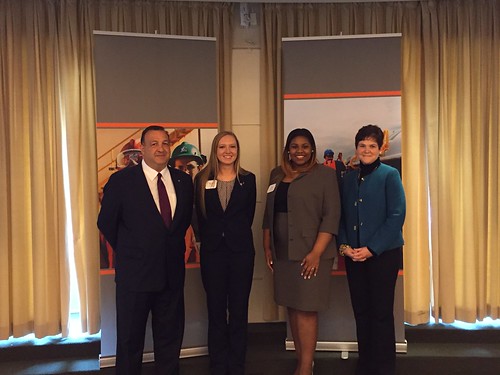
USDA Deputy Secretary Krysta Harden with ADM Chief Human Resources Officer Mike D’Ambrose and students Nicole Ashley Holden and Dara Robertson at the Agriculture Diversity and Inclusion Roundtable in Washington, D.C.
From the field to the fork, we need diversity in agriculture. I’m proud to say that here at USDA, we are doing our part to make sure young people have access to the wide array of opportunities available. Over the next five years, we can expect to see an average of 57,900 jobs become available annually in food, agriculture, renewable natural resources and the environment. However, only 35,400 students will graduate with the specialized degrees and expertise to fill those jobs, leaving 39 percent to be filled by young people with talent in other areas. We need to expand the talent pool and change the dialogue to show agriculture as an attractive, meaningful career path.
Recently, I had the pleasure of participating in a roundtable discussion with leaders from industry, higher education, and the nonprofit sector to share best practices on how we can come together to grow a diverse pipeline of talent for U.S. agriculture. Together, we were able to discuss what’s working, and where we can improve to create opportunities for young people of all backgrounds to ultimately strengthen the ag workforce.
Diversity comes in many forms. For one, there’s diversity of experience. Whether you come from a farming background or not, there are opportunities to get involved in agriculture. Diverse perspectives help expand the reach and efficiency of products and technology developed by industry, and provide critical insight allowing us to improve the quality of services we provide here in the federal government. For businesses, hiring and promoting employees from diverse backgrounds will result in increased profitability, and by broadening the scope of the agricultural workforce, we’re helping to create economic opportunities and foster prosperous careers that can last a lifetime.
Gender diversity is important too. Through our Women in Ag network here at USDA, we’re changing the face of agriculture by empowering women with the tools they need to succeed. Many of our agribusiness partners are taking similar approaches to change the make-up of their executive teams and boards, as well as their employee bases. It’s not always easy being a female leader in a male-dominated industry, but through mentorship and conversations on shared experiences we can take steps to make sure women are recognized as equal partners on farms, in businesses, and in the board room.
I’m optimistic about what’s to come, and I know that by working together and holding each other accountable, we will create a more inclusive agricultural workforce for the future.
No comments:
Post a Comment